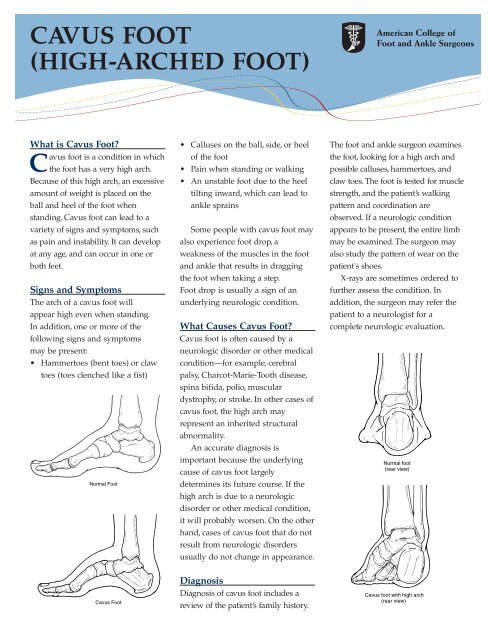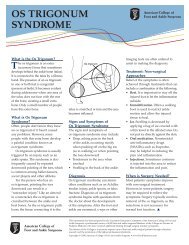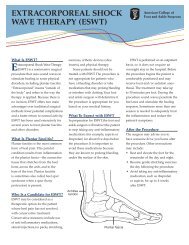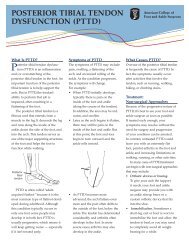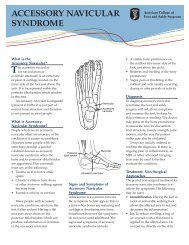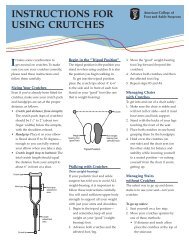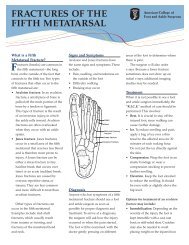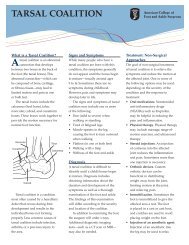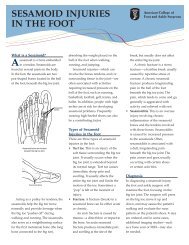CAVUS FOOT (HIGH-ARCHED FOOT)
CAVUS FOOT (HIGH-ARCHED FOOT)
CAVUS FOOT (HIGH-ARCHED FOOT)
Create successful ePaper yourself
Turn your PDF publications into a flip-book with our unique Google optimized e-Paper software.
<strong>CAVUS</strong> <strong>FOOT</strong><br />
(<strong>HIGH</strong>-<strong>ARCHED</strong> <strong>FOOT</strong>)<br />
What is Cavus Foot?<br />
Cavus foot is a condition in which<br />
the foot has a very high arch.<br />
Because of this high arch, an excessive<br />
amount of weight is placed on the<br />
ball and heel of the foot when<br />
standing. Cavus foot can lead to a<br />
variety of signs and symptoms, such<br />
as pain and instability. It can develop<br />
at any age, and can occur in one or<br />
both feet.<br />
Signs and Symptoms<br />
The arch of a cavus foot will<br />
appear high even when standing.<br />
In addition, one or more of the<br />
following signs and symptoms<br />
may be present:<br />
• Hammertoes (bent toes) or claw<br />
toes (toes clenched like a fist)<br />
Normal Foot<br />
• Calluses on the ball, side, or heel<br />
of the foot<br />
• Pain when standing or walking<br />
• An unstable foot due to the heel<br />
tilting inward, which can lead to<br />
ankle sprains<br />
Some people with cavus foot may<br />
also experience foot drop, a<br />
weakness of the muscles in the foot<br />
and ankle that results in dragging<br />
the foot when taking a step.<br />
Foot drop is usually a sign of an<br />
underlying neurologic condition.<br />
What Causes Cavus Foot?<br />
Cavus foot is often caused by a<br />
neurologic disorder or other medical<br />
condition—for example, cerebral<br />
palsy, Charcot-Marie-Tooth disease,<br />
spina bifida, polio, muscular<br />
dystrophy, or stroke. In other cases of<br />
cavus foot, the high arch may<br />
represent an inherited structural<br />
abnormality.<br />
An accurate diagnosis is<br />
important because the underlying<br />
cause of cavus foot largely<br />
determines its future course. If the<br />
high arch is due to a neurologic<br />
disorder or other medical condition,<br />
it will probably worsen. On the other<br />
hand, cases of cavus foot that do not<br />
result from neurologic disorders<br />
usually do not change in appearance.<br />
The foot and ankle surgeon examines<br />
the foot, looking for a high arch and<br />
possible calluses, hammertoes, and<br />
claw toes. The foot is tested for muscle<br />
strength, and the patient’s walking<br />
pattern and coordination are<br />
observed. If a neurologic condition<br />
appears to be present, the entire limb<br />
may be examined. The surgeon may<br />
also study the pattern of wear on the<br />
patient's shoes.<br />
X-rays are sometimes ordered to<br />
further assess the condition. In<br />
addition, the surgeon may refer the<br />
patient to a neurologist for a<br />
complete neurologic evaluation.<br />
Normal foot<br />
(rear view)<br />
Ca<br />
Cavus Foot<br />
Diagnosis<br />
Diagnosis of cavus foot Normal includes foot a<br />
(rear view)<br />
review of the patient’s family history.<br />
Cavus foot with high arch<br />
(rear view)
Treatment: Non-Surgical<br />
Approaches<br />
Non-surgical treatment of cavus foot<br />
may include one or more of the<br />
following options:<br />
• Callus care. The surgeon often<br />
trims the calluses and<br />
recommends wearing small pads<br />
around the calluses to reduce<br />
pressure and pain. Patients<br />
should never attempt to trim<br />
calluses themselves, since this<br />
could do more harm than good<br />
and possibly result in an<br />
infection.<br />
• Orthotic devices. Custom orthotic<br />
devices that fit into the shoe can<br />
be beneficial because they<br />
provide stability and cushioning<br />
to the foot.<br />
• Shoe modifications. High-topped<br />
shoes support the ankle, and<br />
shoes with heels a little wider on<br />
the bottom add stability.<br />
• Bracing. The surgeon may<br />
recommend a brace to help keep<br />
the foot and ankle stable. Bracing is<br />
also useful in managing foot drop.<br />
When is Surgery Needed?<br />
If non-surgical treatment fails to<br />
adequately relieve pain and improve<br />
stability, surgery may be needed<br />
to decrease pain, increase stability,<br />
and compensate for weakness in<br />
the foot. Surgery is also considered<br />
for cases that are likely to get<br />
worse—even if there is currently<br />
no pain or instability. In these<br />
instances, the goal of surgery is to<br />
help reduce the severity of<br />
future problems.<br />
The surgeon will choose the best<br />
surgical procedure or combination of<br />
procedures based on the patient’s<br />
individual case. In some cases where<br />
an underlying neurologic problem<br />
exists, surgery may be needed<br />
again in the future due to the<br />
progression of the disorder. ▲<br />
This information has been prepared by the Consumer Education Committee of the American College of Foot and<br />
Ankle Surgeons, a professional society of 6,200 foot and ankle surgeons. Members of the College are Doctors of<br />
Podiatric Medicine who have received additional training through surgical residency programs.<br />
The mission of the College is to promote superior care of foot and ankle surgical patients through education,<br />
research and the promotion of the highest professional standards.<br />
Copyright © 2007, American College of Foot and Ankle Surgeons • www.FootPhysicians.com


